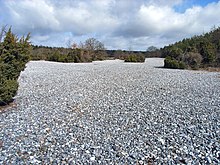Flint fields
Flint fields are scree fields made of flint . These are partly relocated (resedimented) weathering residues of flint-bearing, mostly Jurassic and Cretaceous limestones .
In Germany, flint fields can be found in Aachen -Lousberg, Kleinkems , Schernfeld , Osterberg near Pfünz, Baiersdorf , Abensberg - Arnhofen and Lengfeld as well as on Rügen .
Flint fields on Rügen
On the island of Rügen, flint fields extend between Mukran and Prora in the northern part of the Schmalen Heide ( 54 ° 27 ′ 59 ″ N , 13 ° 33 ′ 27 ″ E ). They are also called "Stone Sea" and cover an area of 40 hectares (2000 m × 200 m). During a series of storm surges before 3500 to 4000 years the stones that over time were from the chalk - cliffs of the peninsula Jasmund weathered out and had initially accumulated at the foot of Kliffes, transported to this place and deposited. Because of the relatively high thickness of the sterile flint deposits, these have only been sparse to this day.
In 1840, the Schmale Heide was planted with a pine forest, which today closely frames the flint fields. Since 1935, when the area was placed under nature protection, many trees, shrubs and other plant species have been able to develop undisturbed. These include two meter high striped ferns , holly and especially juniper bushes . As early as the middle of the 19th century and most recently from the middle of the 1970s to the beginning of the 1990s, attempts were made to protect the 14 exposed flint walls, around 25 meters wide and one meter high, from excessive vegetation development by partially fencing in and stocking game.

